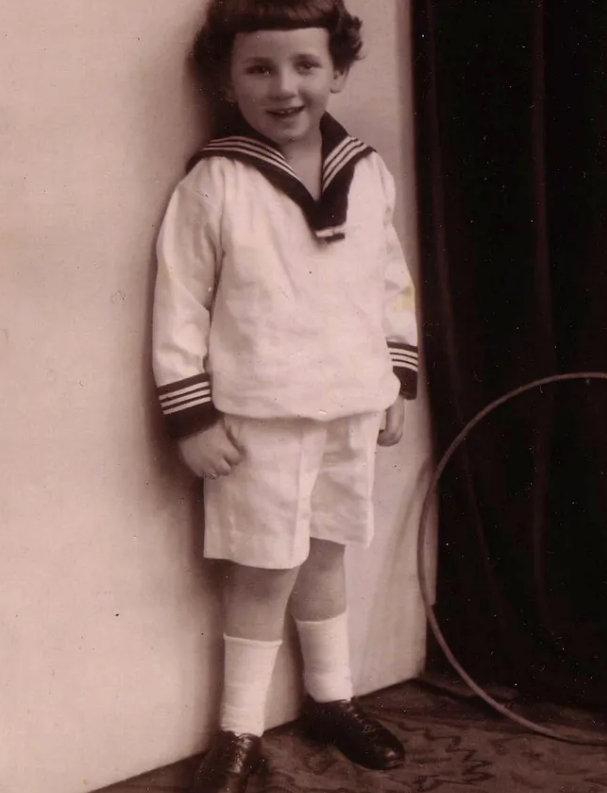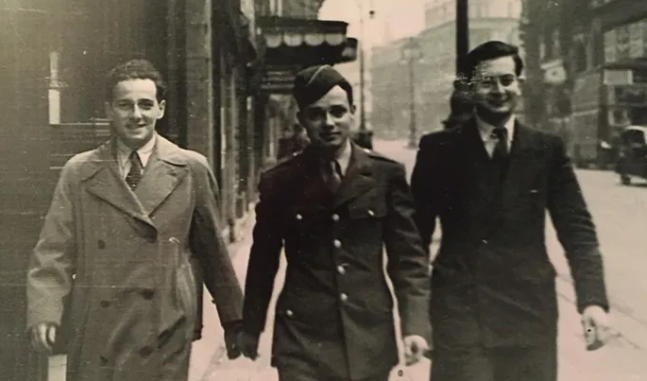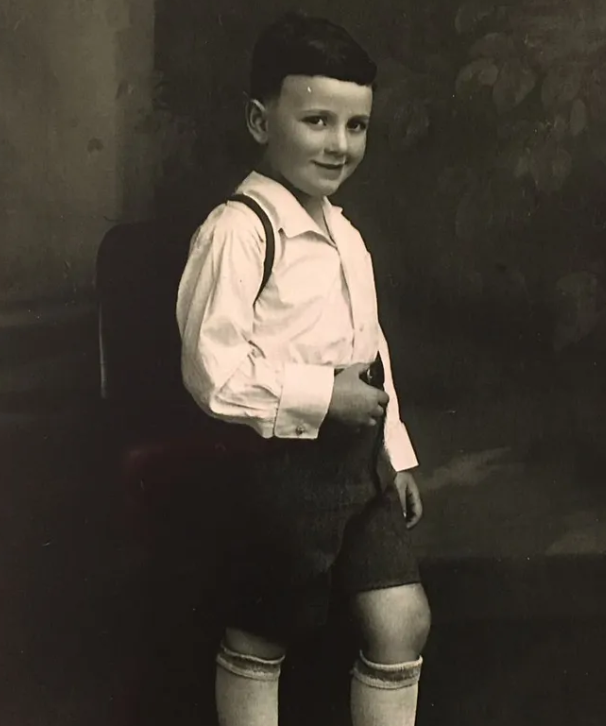David Hochstein was a Holocaust survivor from Cologne, Germany. His story is one example of a teenager’s resilience, perseverance, and strength, during the Holocaust.
Rescued by a Kindertransport, he was taken to London when he was 15. The Kindertransport movement was unique in that people of many religions came together to rescue 10,000 mostly Jewish children, bringing them to Great Britain.
Here is his story.
David’s Childhood: Family, Friends, and “Lots of Cousins”
David was an only child and his parents pampered him. The family lived in a large apartment with a courtyard. The family took riverboat trips on the Rhein, went mountain climbing, and often visited relatives in Dusseldorf, Holland and Belgium.
He had lots of cousins who were about his age and they treated him like a sibling. Even at a young age, David would travel by himself for extended visits. When he was 14, he spent an entire summer with his cousins in The Hague, Holland.
Herrman Rosenfeld, Sigi Reichenfeld, and Harry Ader were his best friends. They played soccer, swam in the Rhein River, and rode bikes all around the city. He even built his own radio and collected stamps.
He grew up in an observant Jewish family. He went to synagogue with his father every Saturday. He attended Hebrew school and had a Bar Mitzvah at the age of 13. After Hitler came to power in 1933, life became increasingly difficult for the Jews in Germany. More than 400 new laws were passed that restricted their personal lives, civil rights, education, employment, and business opportunities.
Friendships between Jews and non-Jews — even children — ended. Neighborhood boys that David and Herrman and Sigi had played soccer with all their lives were suddenly not allowed to play with them because they were Jewish.
When laws restricted the number of Jewish students allowed to attend public schools, there were many new students at the Jewish high school that David attended. When Jewish professors who had been on faculty at the best universities in Germany were no longer allowed to teach non-Jews, they became teachers at Jewish schools.

The day everything changed
David was getting ready for school when the Nazis banged on the apartment door at 5 a.m. on Friday, October 28. He didn’t go to school that day or ever again. Instead, he and his parents were taken from their home to the train station and, without any warning, my father and his parents were deported.
Because his parents had been born in an area of Austria that had originally been Poland, they were rounded up with about 17,000 other Jews of Polish nationality living in Germany and deported to Zbaszyn, a small town on the Polish border. The Polish government didn’t want them and tried to get the Germans to take them back. Germany didn’t want them back.
People took shelter in the stables of a military riding school and in a flour mill, made arrangements with private citizens, or just lived on the streets. Some trucks arrived with bread and tea. By December, Jewish organizations had set up a refugee camp and tended to the refugees’ basic needs. His family was able to stay with the town postman and David helped deliver the mail. Many people left to stay with relatives in other parts of Poland. Some were able to get visas and emigrate.
Until the start of World War II when the borders closed, Jews were allowed to leave Germany if they had a visa from another country. Tens of thousands of Jews left after Hitler rose to power, like David’s friend Harry Ader’s family who emigrated to New York. As time went on, it became almost impossible to get a visa from any other country. Jews were trapped in Hitler’s Reich, obviously suffering terribly, but unable to find countries willing to take them in and give them refuge.
Even after Kristallnacht, a wave of violent anti-Jewish pogroms in Germany and Austria, November 9–10, 1938, very few countries were willing to take in Jewish refugees. Finally, British public opinion and persistent pressure from refugee aid committees convinced the government to allow unaccompanied children under the age of 17 from Germany, Austria, Czechoslovakia, and Poland to enter Great Britain.
Kindertransport to London
Children were admitted on temporary travel documents, with the idea that they would rejoin their parents when the crisis was over. A £50 Pound Sterling bond had to be posted for each child “to assure their ultimate resettlement.”
These rescue operations, called Kindertransports or Children’s Transports, began in December 1938. Jewish organizations inside the Greater German Reich planned the transports. Many organizations and individuals assisted in settling the children in the United Kingdom. The Kindertransport movement was unique in that Jews, Quakers, and Christians of many denominations worked together to rescue primarily Jewish children.
One of these Kindertransports, organized by these good English people — all strangers — saved David’s life.
To get his son on a Kindertransport, David’s father had to find someone in England to post the £50 bond. Somehow, he located a distant relative in London and she agreed to be his sponsor. David had never heard of her before and has no idea how she was related.
With her sponsorship, he was one of the 50 children allowed to get on the Kindertransport. His father was given a scribbled note on a scrap of paper: “The son of Samuel Hochstein is allowed to board the train.”
Parents or guardians could not accompany the children. Infants and young children were cared for by older children on their transport. They all expected to rejoin their parents when the crisis was over.
He thought it would be an adventure. He didn’t think that the day he boarded the train would be the last time he saw his parents.
David’s Kindertransport left Zbaszyn, Poland in February 1939. The children were very undernourished. Before they could travel, they were cared for by a Jewish organization in a suburb of Warsaw. They were fed and put on a scale every day until they were healthy enough for travel. Then they were bussed to the port of Gdańsk where they boarded a ship with about 500 other children. They sailed through the Kiel Canal and on to Great Britain.
I never thought that the day I boarded the train would be the last time I saw my parents. The last words my father spoke to me were, ‘Never forget that you are a Jew.‘
— David Hochstein, Holocaust survivor
Other Kindertransports collected children in Germany, Austria, and Czechoslovakia. By the time the last Kindertransport left Germany on September 1, 1939 — just two days before Great Britain entered the war, approximately 10,000 children had been rescued.
The Kinder, as the children came to be known, were dispersed to many parts of the British Isles. About half lived with foster families, Jewish and non-Jewish; others lived in hostels, group homes, and farms. Those older than 14, unless they were fortunate enough to be sponsored by individuals and sent to boarding schools or taken into foster care, were frequently absorbed into the country’s labor force.
David’s relatives saved his life by sponsoring him, but they didn’t offer him a place to live. Although he had been an excellent student and his parents had hoped he would become a doctor, the relatives couldn’t pay for his education. He needed to support himself.
So in March 1939, at the age of 15½, he became an apprentice furrier at the London Fur Company. On a salary of £1 a week plus a daily bottle of milk, he had to support himself. He was placed in a boarding house and was provided with room and board. The house was owned by a Spanish Portuguese Jewish family. The daughter, Esther Friedlander, took a special interest in David and treated him like a younger brother. The other nine boarders were all adults.
David was fortunate that he had learned some English in school but everything else was foreign to him. He was in a strange country, no longer a student, with no family to guide him. The only place he felt comfortable was in synagogue. When he went to Sabbath services, he was comforted by the familiar Hebrew prayers, the same ones he had learned at his father’s synagogue in Germany.
He was 15½ years old, a growing teenager. He was always hungry and always outgrowing or wearing out his clothes and shoes. There was no extra food and there was no one to buy him clothes or shoes. He mended his clothes himself. The cobbler let him make payments for his shoe repairs. When he couldn’t make the payment, he would walk home the long way so he wouldn’t pass the shop.
He lived through the Blitz, September 1940 — May 1941, when the Germans bombed London 71 times and killed about 20,000 people. At nightfall, the boarding house residents would all go to a shelter in the backyard made of corrugated steel and listen to the air raid sirens.
David eventually reconnected with his friend Sigi Reichenfeld who he had gone to school with in Cologne. Sigi had also been able to get on a Kindertransport. The two visited each other as much as they could and they socialized with other young refugees at the International Club in London.

When he first got to London, David received letters from his parents, but after the war started, he no longer received any mail. Sometime in 1941, he received a postcard that had been sent through Cooks Travels to Portugal and then forwarded to him in London. That was the last he heard from his parents. They worried that he had warm clothes for the winter.
The furrier apprenticeship was for six years. David gradually became a highly skilled furrier, learning how to create any type of garment out of any type of fur. One of his projects was making leather flying jackets for the English pilots fighting the war.
The war finally ended in 1945 and he tried to find his family. He learned that his parents had been sent to a concentration camp in Poland and killed. His aunt, uncle and three cousins in Holland and his aunt, uncle and two cousins in Dusseldorf had all been killed. The relatives in Belgium had been hidden by neighbors during the war and they all survived. His friend Herrman Rosenfeld and his family had been killed.
In 1946, after living in London for seven years, he decided to start a new life in America. He visited the family in Belgium before he left. They begged him to stay but he was determined to leave all of Europe behind.
Join the Nancy & David Wolf Holocaust & Humanity Center for a special conversation with Cheryl Hecht, the daughter of Holocaust survivor David Hochstein, at Union Terminal on May 7, at 11 a.m., in Reakirt Auditorium. Cheryl Hecht tells the story of her father, David Hochstein, a Holocaust survivor from Cologne, Germany. Rescued by a Kindertransport, he was taken to London when he was 15. The Kindertransport movement was unique in that people of many religions came together to rescue 10,000 mostly Jewish children, bringing them to Great Britain. David’s story is one example of a teenager’s resilience, perseverance, and strength, during the Holocaust. Cheryl has worked as a professional and volunteer in the Jewish community. A graphic designer, she recently retired from the Mayerson JCC after 19 years. REGISTER NOW.
